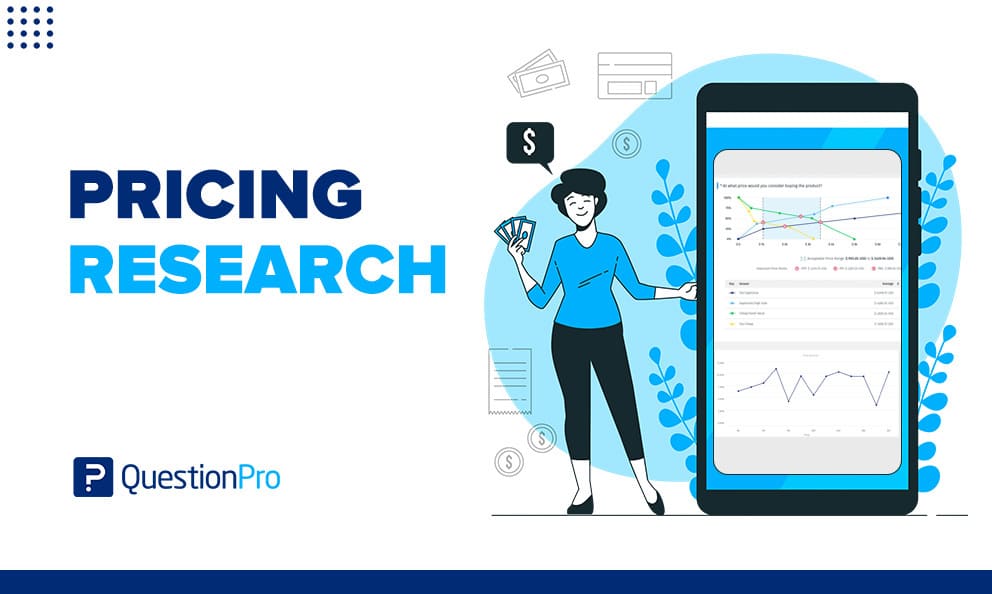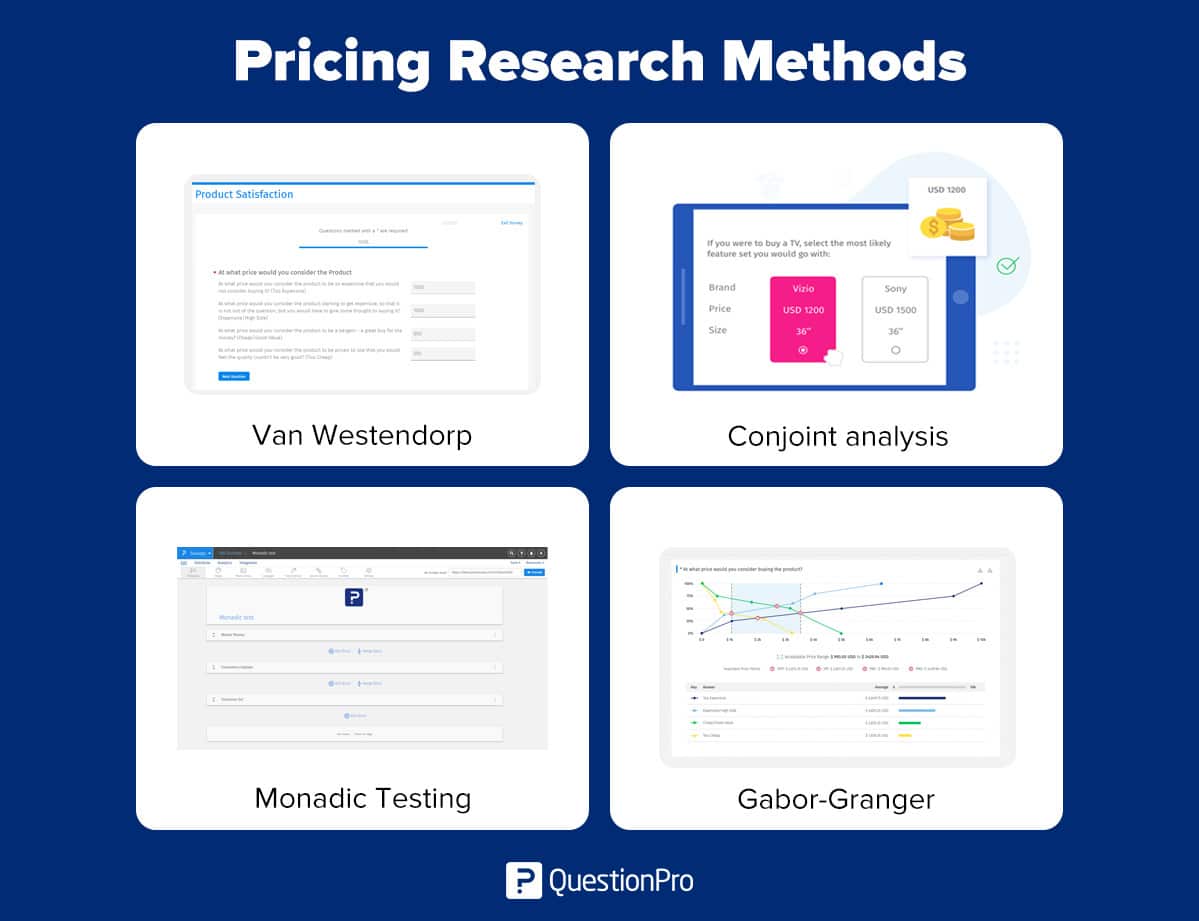
Typically, as a customer, you know how much you are willing to pay for some products or services, but as a company? It is essential to know our customers’ perceptions when setting our prices. Today, we’re talking about conducting pricing research.
The decision-making process to establish prices considers the market’s capacity, considering the willingness of customers to buy. However, you should consider undertaking pricing research to identify an optimal price point that balances customer satisfaction, product value, and revenue.
So, let’s ask ourselves: how can we conduct pricing research effectively? Continue reading, and we will discover the answer together.
What is Pricing Research?
Pricing research is a method used to evaluate the optimal price range for a product/service. It studies the changes in demand and supply within the market. Pricing research is valuable for understanding our options in relation to our competition.
It’s a fantastic tool to identify improvements we can make to get ahead of them. This research can help you determine the optimal price for your target segments, the trade-offs between price and quality, price sensitivity, and probable reactions to rivals’ prices.
As we can see, the primary purpose is to enhance profitability by observing and analyzing behavioral pricing. This approach allows us to learn how prices affect business growth and development, ultimately impacting sales.
We conduct pricing research to increase revenue and reduce costs. These results can be achieved by optimizing the prices of our products or services in the marketplace. However, it’s fair to remember that pricing research is quantitative in origin. This fact means we’re focusing on a specific number of people and, in fact, gathering quantitative data from them.
Remember, pricing research is applied to regularly assess your pricing strategy development. In fact, it is used for marketing efforts when evaluating new ideas, launching new products or services, and making essential adjustments to our pricing strategies.
Why is Pricing Research Necessary?
First of all, pricing research provides a strategic initiative and frame of reference for launching a product/service or adding new features. It’s a sounder on your boat. Of course, you can sail, relying on your experience and gut feeling, but in that case, you will be sailing in circles within the waters.
Secondly, you can tell pricing study is a must-exercise for new horizons, markets, startups, and successful competition. By getting absolute numbers from them, you clarify consumer expectations and the elasticity of demand. This practice will increase the chances of customer loyalty.
When running price research, you understand the limits of the price range available, allowing you to take a swing at maximizing profits.
Another important thing: price research provides insight into how 1-2% of price changes can yield 10-20% of profits.
Pricing Research Methods
There are many definitions of existing research methods, especially the “branded” versions of the same method by different vendors; it can be confusing.

Therefore, it is more manageable to start with your goalkeeping in mind. The main objectives according to each method are the following:
1. Van Westendorp
Van Westendorp’s price sensitivity method identifies fundamental psychological price points by surveying consumers and understanding how much they’re willing to spend on a product according to their answers.
Here, you ask four questions:
- At what price would you consider the product too expensive to buy?
- At what price would you consider it getting expensive, but still worth considering?
- At what price would it be a bargain?
- At what price would it seem too cheap to be good quality?
As a result, it enables us to notice a range of prices that might be appropriate and to see the fall-off in consumer interest that occurs as the price rises.
2. Conjoint Analysis
We’re talking about conjoint analysis, a survey-based market research method that allows us to study people’s processes while making complex decisions. Even decisions like choosing a pair of shoes or finding a restaurant represent mental conjoint studies that lead us to our choice.
To apply this method, you create different versions of your product by mixing various features and price points. Then, you present these combinations to your target audience and ask which one they would most likely buy. This helps you uncover what truly matters to them when it comes to value, and how much they’re willing to trade one feature for another.
Imagine you’re creating a subscription box for fitness gear. You come up with a few combinations:
- Option A: Resistance bands and a water bottle for $39
- Option B: Yoga mat and workout guide for $49
- Option C: Resistance bands, water bottle, and mat for $59
You run a survey with 1,000 participants. The results show that most people prefer the $49 option. It strikes the best balance between usefulness and affordability. They’re not necessarily looking for more items; they’re looking for the right combination.
By using conjoint analysis, you learn what features your customers care about most, and what they’re willing to pay for them. That insight helps you design a product that aligns with real demand, not assumptions.
3. Monadic Testing
It’s a set of questions that asks the respondents’ opinions about a concept and which precise attributes and features they like or dislike. The target audience is divided into multiple groups that are presented with one of the concepts and asked questions about it.
Let’s say you’re testing pricing for a new productivity app. You want to see how people react to different monthly subscription rates. So you set up your survey like this:
- Group A sees the $5/month plan
- Group B sees the $10/month plan
- Group C sees the $15/month plan
Each group answers questions like:
- Would you subscribe to this plan at this price?
- How valuable does this plan seem to you?
The goal is to compare the feedback across all three versions. If Group B shows the highest interest and perceives the most value, you’ve likely found your sweet spot. Monadic testing helps you avoid bias by keeping comparisons clean and straightforward. Each person sees only one option, so their responses are more focused and realistic.
Gabor-granger
A pricing question is used in survey research to specify the price elasticity of products and services. Determining a product’s or service’s price is an essential step and one of the most critical decisions for any organization.
In this method, you ask whether someone would buy a product at a specific price. Based on their response, you either raise or lower the price in the next question to better understand their threshold.
Imagine you’re pricing a new online course. You start by asking, “Would you pay $49 for this course?”
- If the person says yes, the next question bumps the price up to $59.
- If the answer is no, you lower it to $39.
You repeat this flow with hundreds of users. Over time, you’ll start to see where people begin saying “no” more frequently. If most say “yes” up to $44, but start dropping off after that, you’ve just found your sweet spot. This is how Gabor-Granger helps you lock in a price that balances buyer interest and potential revenue.
Let’s recognize that all products have a price. Until recently, costs were considered the responsibility of the financial departments of companies and were set based on quantitative mechanisms and independently of the rest of the marketing variables.
Pricing is actually pretty simple: Customers will not pay literally a penny more than the product’s true value. – Ron Johnson.
LEARN ABOUT: Research Process Steps
FREE WEBINAR: The price is right! Introduction and Tools for pricing research
Pricing Research Examples
Have you ever asked yourself, “How are we making a profit selling products and services at that price?”
Esther LaVielle first questioned this at her first job in high school, selling cookies at the mall. The shop charged $1.50 for each cookie and $1.29 for soda; it had about 25 customers. If you don’t have a calculator at hand, that adds up to +$70 an hour: not very much. When you factor in overhead and cost of labor, you have a shop going out of business in its first year.
This story portrays the importance of getting pricing right, as it could mean having to put employees out of work.
Pricing is hard to get right, overpricing can turn off customers, and underpricing can make your product seem cheap. Not to mention, you have to factor in competitors’ prices and employee salaries; the list of confounding variables is that affect price sensitivity seemingly endless.
At this stage, pricing research can be beneficial.
For instance, understanding what features within products and services are most important to your target audience and their willingness to pay for valuable items. This knowledge will allow businesses to focus on product strengths, as this will dictate the proper pricing model.
Take Apple, for example; why are so many people willing to pay so much for an iPhone? They did a great job studying their high-level users and focused on the essential features: photography, gaming, app development, and music. High-level users will pay a premium for the best technology and experience in these areas.
This practice incentivized Apple to invest heavily in these technology areas— users and usage lead to better products. Now people are foaming at their mouths to pay over USD 1,000.
How to Do Pricing Research
Pricing research sounds technical, but at its core, it’s just about understanding what your customers are truly willing to pay. Using a good survey tool makes this much easier. Here’s how you can run pricing research step by step.
Step 1: Define Your Objective
Before writing a single question, ask yourself why we’re doing this. What decision will this research help us make?
- Are we launching a new mobile app and need to set an entry price?
- Are we trying to decide if people would pay more for added features in our current product?
- Are we comparing two pricing models: subscription vs one-time purchase?
Step 2: Choose Your Audience
Who are we targeting?
Your pricing insights will only be useful if they reflect your real customers. Use demographic filters, behavioral data, or CRM segmentation to target the right respondents. For example, if you’re launching a premium subscription for design software, survey freelancers, agencies, or power users, not just anyone.
Step 3: Select the Right Pricing Method
Each method gives us a different type of insight:
- Van Westendorp to find acceptable price ranges
- Conjoint Analysis to compare features and price combinations
- Monadic Testing to evaluate how people respond to specific price points
- Gabor-Granger to determine price elasticity and revenue sweet spots
The choice depends on whether we’re testing price tolerance, product configurations, or the influence of competitor pricing.
Step 4: Build a Simple and Clear Survey
We should keep our questions straightforward. Avoid anything that feels too long or too technical. We can use sliders, multiple choice, or side-by-side comparisons, depending on the method you choose. Also, we can add logic where needed, like showing different prices based on responses.
A few useful question types:
- At what price would this product feel like a good deal?
- Which version of this product would you most likely buy?
- Would you pay $49 for this product?
We need to ensure that each person sees what they need to see.
Step 5: Send It Out and Gather Responses
Use your email list, social media, or paid panel services to get enough responses. A good rule of thumb is to aim for at least 100 completed responses per variation, especially if you’re running something like monadic testing or conjoint analysis.
Make sure the people answering your survey match your target customer. If you’re targeting tech professionals, don’t send it to a general audience.
Step 6: Review the Results and Find Your Answer
Once you’ve got the data, look for trends. Which price ranges had the most positive feedback? Which features drove the most interest? Where did people start to back off?
The conjoint or Gabor-Granger method helps to see graphs showing preference shares, willingness to pay, and revenue estimates. These insights will help you build pricing models that make sense both for your business and your customers.
If you’re using QuestionPro, you’ll find everything you need to run pricing research in one place. The platform makes it easy to build surveys using all the methods we’ve talked about: Van Westendorp, conjoint analysis, Gabor-Granger, and monadic testing.
You can also target specific user groups, randomize options, and view real-time analytics without needing to export data into other tools. Whether you’re testing one product or many, QuestionPro helps you run pricing research faster and with more confidence.
Conclusion
Now you know what pricing research is and what it can do for your company. Therefore, we invite you to explore new opportunities, evolve the strategy, and meet our customers. All of these actions are necessary and exciting for any company.
Of course, any research method is helpful for a project; one of them is pricing research. As we’ve learned today, price research will improve the general quality and market positioning with a firm scientific basis when used correctly.
Since we’re talking about quantitative data, implementing expert research software is the best and most precise way to run a pricing research strategy. Uncover the insights that matter the most.
With QuestionPro, you can manage your pricing research the right way. QuestionPro is the perfect pricing research software to uncover complex insights that can propel your business to the forefront of your industry.
We address the most common question types for pricing research studies, as well as the ability to analyze large volumes of data in real-time to identify the optimal price adjustment for your product or service.
If you don’t have a target audience to survey, you can reach one in seconds with QuestionPro Audience, our sample service that covers a wide range of profiles nationwide.
Frequently Asked Questions (FAQ)
Answer: Pricing research is a type of research that examines and evaluates the influence of price changes on a product’s demand. Organizations use it to decide the best price for new items in order to maximize revenue and market share.
Answer: Pricing research provides you with the customer information you need to make intelligent pricing strategy decisions. Whether you intend to raise your rates or are considering pricing a new product, research is the key to an efficient pricing strategy.
Answer: One of the most effective pricing techniques for retail businesses is the cost-plus approach. They can charge different markups depending on the things they supply.







